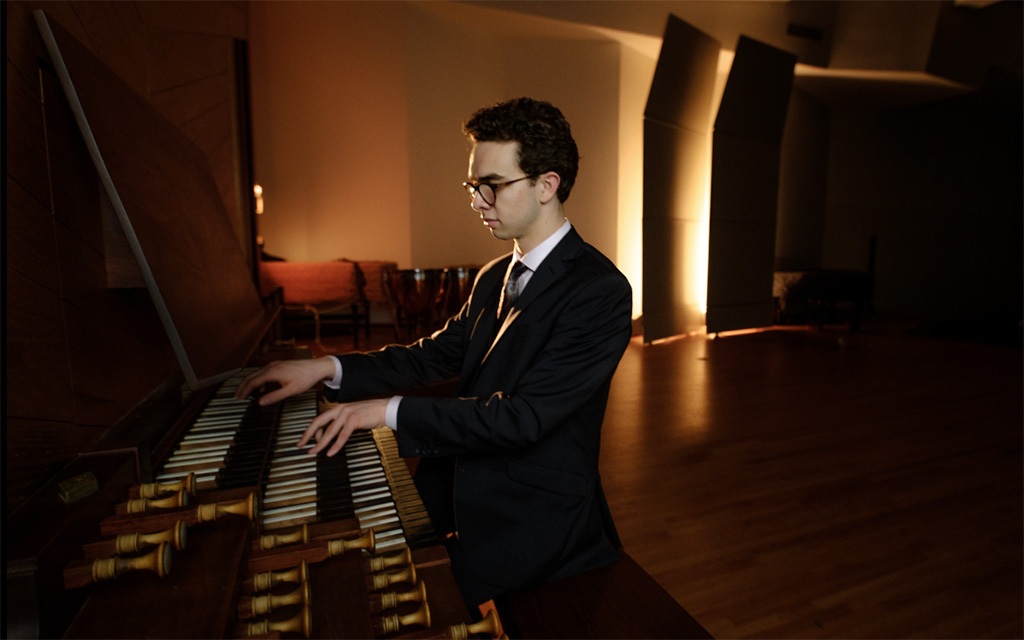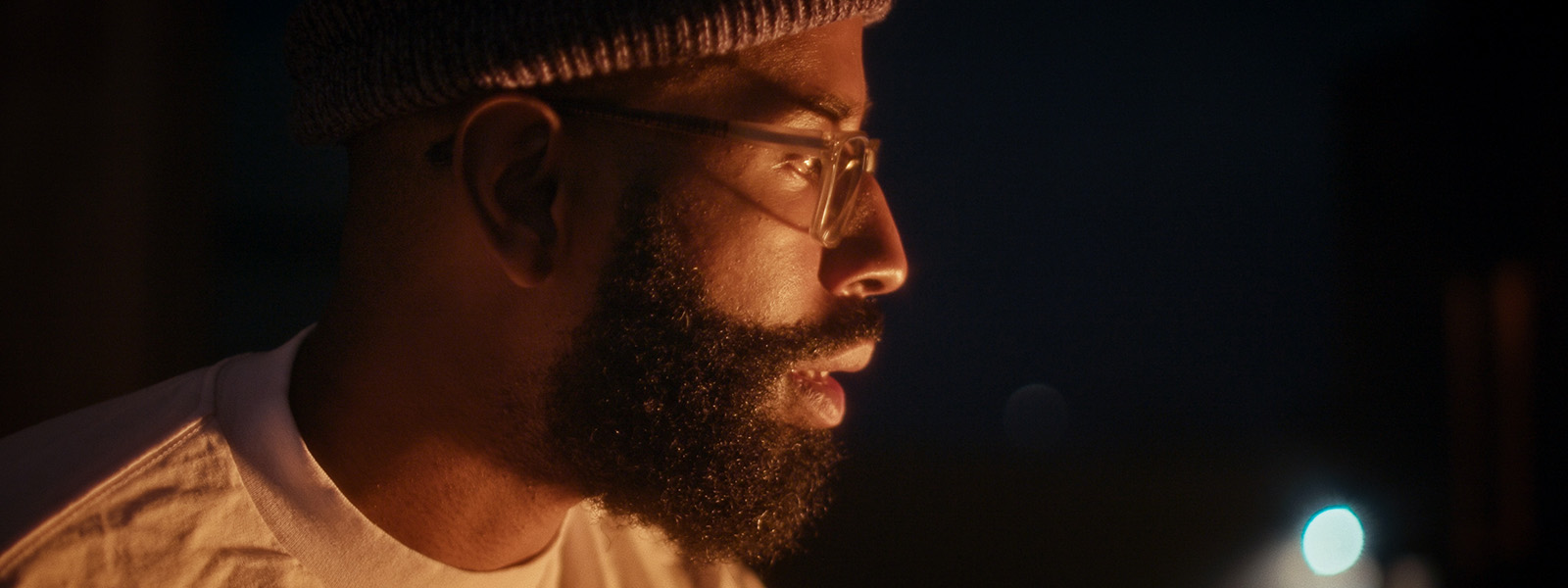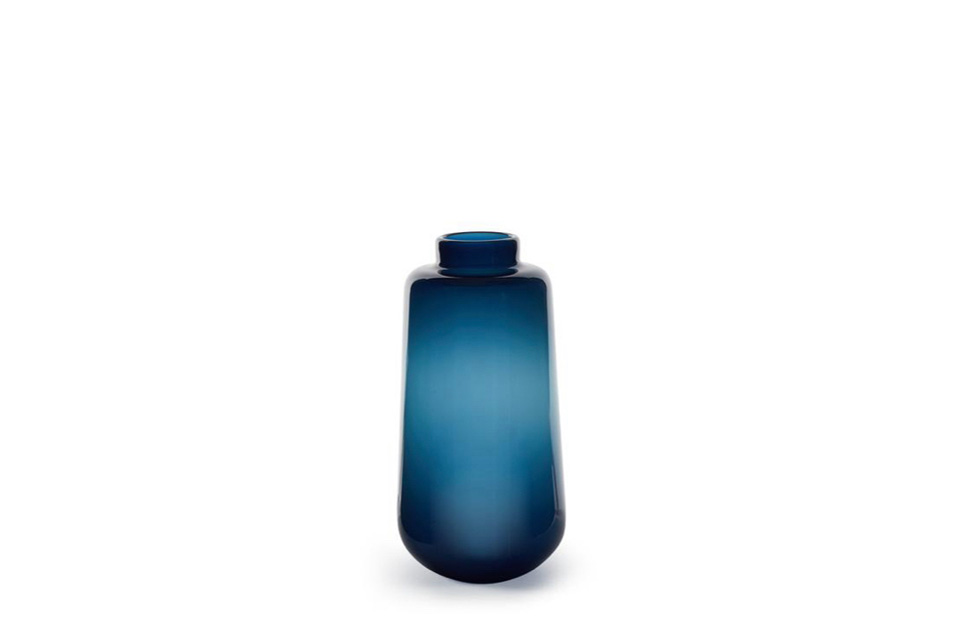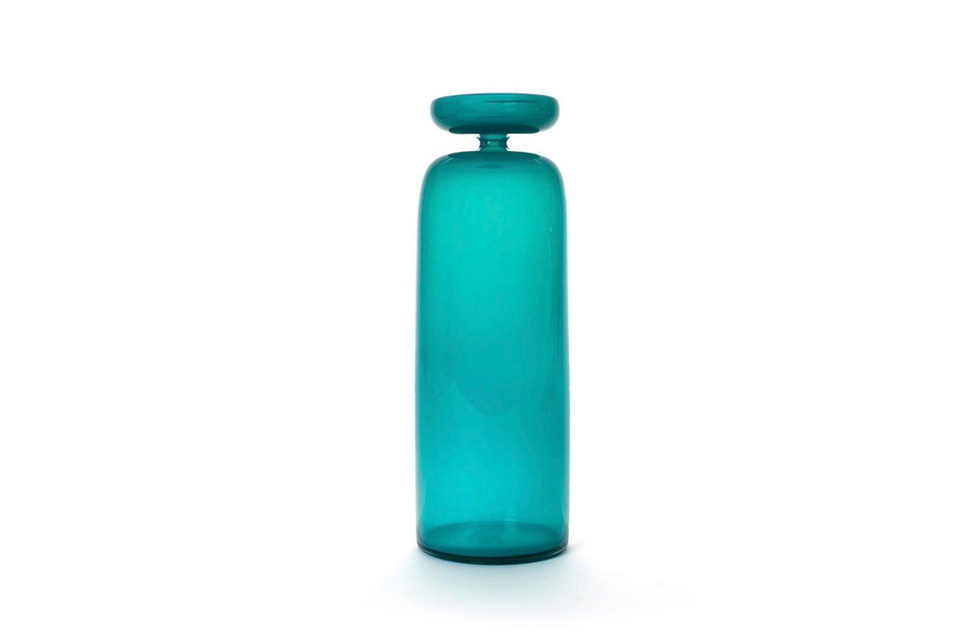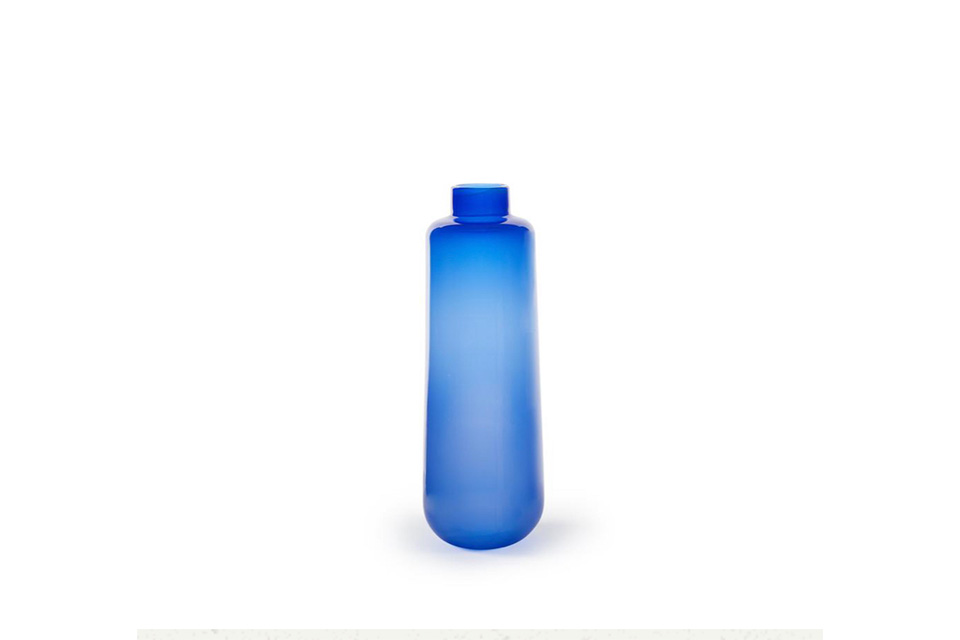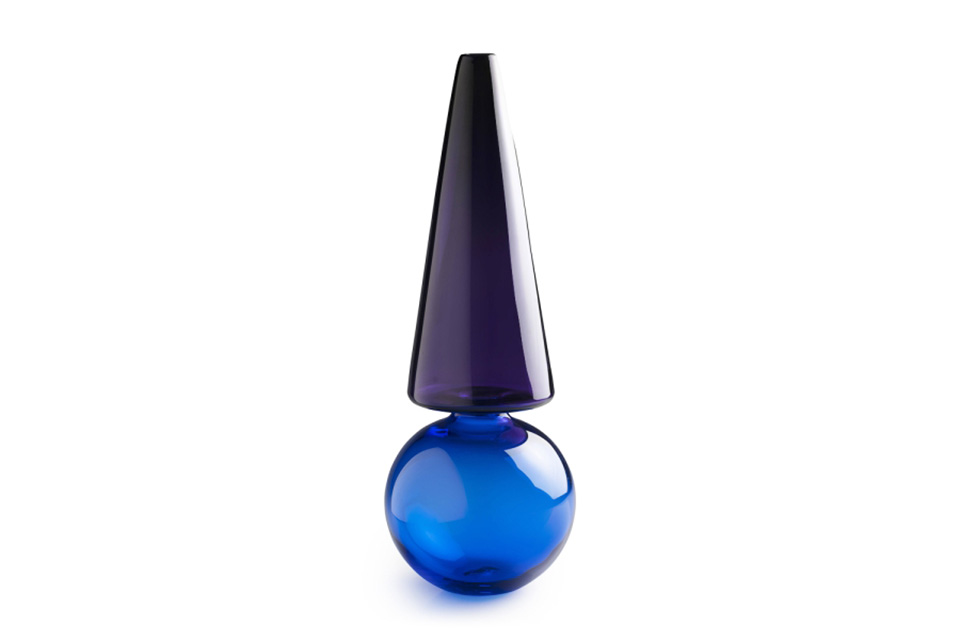Cedric Mitchell
The views and opinions expressed by speakers and presenters in connection with Art Restart are their own, and not an endorsement by the Thomas S. Kenan Institute for the Arts and the UNC School of the Arts. This interview has been edited for length and clarity.
Cedric Mitchell is a glass artist based in Los Angeles who for the last 10 years has created an array of both decorative and functional pieces. He has completed residencies at some of the most prestigious craft institutes in the country, including Penland School of Craft, Pilchuck Glass School and Corning Museum of Glass. In 2018, he officially launched his own business, Cedric Mitchell Design, through which he continues to create blown glass for retailers nationwide.
Cedric is also the events-and-resource manager for Crafting the Future, a nonprofit that works to diversify the fields of art, craft and design by connecting BIPOC artists with opportunities that will help them thrive. In the last three years, Crafting the Future has provided 70 scholarships for artists and craftspeople to attend instructional programs throughout the country.
In this interview with Pier Carlo Talenti, Cedric, who to this day remains one of the very few Black glass blowers in the field, describes how a combination of curiosity, initiative and generosity has led him to be an admired professional as well as a mentor in the field.
Choose a question below to begin exploring the interview:
- How did you end up discovering that glass was your medium?
- What are your favorite moments in the process of making glass?
- Is there anything in your musical background that connects to glass?
- Was it hard to tell your family that you were going to become an artist full-time and not pursue the business degree?
- How did you decide to get involved with Crafting the Future?
- What have you learned about yourself, doing the kind of work that you’re doing with Crafting the Future?
- In terms of diversifying the glassmaking field, is there kind of a no-brainer way in which a system could be reinvented so that the field could be more diverse?
- How do you think the art of glass would benefit from having a more diverse set of artists working in it?
- How would you describe your own flare and style?
- When you’re working on new pieces, do you make a distinction between what’s going to feed the business side versus the purely artistic?
- How did you create relationship with Heath Ceramics?
- Can you talk about any projects or experimentations that you’re particularly excited about on those days of imagination?
Pier Carlo Talenti: Let’s take it back from when you were starting as a glass artist. How did you end up discovering that glass was your medium?
Cedric Mitchell: I’m originally from Tulsa, OK. I moved to Los Angeles about seven years ago. When I was in Tulsa, I was actually a hip-hop artist or rap musician. I was also enrolled at the Tulsa Community College there, studying my basics for business.
One day, I was at the studio with my friend Steve, and we came about the conversation of glass and glassblowing. He informed me that there was a glass studio in downtown Tulsa, and they offered glassblowing as an elective through the community college. So I was-
Pier Carlo: It’s not every day that people start talking about glassblowing. How did it come up?
Cedric: Oh, well we were taking a smoke break, so he had a bong.
Pier Carlo: [Laughing] Gotcha!
Cedric: And he was telling me about his friend who made the bong in Miami, and he was a glass artist.
Pier Carlo: It was an artisanal bong!
Cedric: Back then, I didn’t think about how glass was made, so it was kind of intriguing to know that’s how it was made, in the studio. That was my impression signing up for the class, like, “OK, cool, I’m going to make bongs and pipes.”
We were in the studio, it was about 1 am, and I just pulled up the community-college website and enrolled myself in the class without really doing any research or anything. I showed up to the studio first day of class, and that was the first thing that they said: “We will not be making any bongs or pipes because it’s a non-profit organization.”
Pier Carlo: When you hear, “Don’t do drugs thing; don’t smoke weed in school,” they don’t tell you it might turn you into an artist. That’s the good part of it!
Cedric: [Laughing] Exactly, yeah.
Pier Carlo: What are your favorite moments in the process of making glass?
Cedric: I would have to say all of it. It’s really a very difficult medium, and it takes a lot of planning and being proactive. You can’t really be reactive to the material because sometimes things don’t go as planned.
At the same time as I started blowing glass, I was training with my brother, who’s a boxing trainer. I was training with him for about three years. It had certain similarities. It’s kind of like chess in a way, but except for being penalized with a punch, you have to react on the fly. It takes a lot of mental stability and a lot of physical effort as well. It’s a very tense thing, working with this material. Sometimes it could break, it’s fragile and it might not be going well. And it’s hot.
And everybody can’t do it. That’s the one thing that really drew me in, that this is something that I can do that no one can just come in and just pick up right off the bat. A lot of people think that they can, and it takes years and hours of practice to gain certain skillsets, even the basic skillsets.
Pier Carlo: How long have you been doing it now?
Cedric: I’ve been doing it 10 years now. I hit the 10-year mark in September.
Pier Carlo: Congrats. You mentioned similarities between glassmaking and your experience boxing, but I’m also curious, given your background in rap and music, if there was anything in your musical background that was relevant to glass?
Cedric: In the sense that you have to move in a rhythmic motion. It’s about timing as well. A lot of what we do is based around heat management and knowing what to do and timing and then communication in working. You have to be vocal in the glass studio. You really can’t be shy. You have to be vocal, you have to be present and you have to be alert.
And the rhythm and the noises too that the studio makes. It’s a lot of different sounds and noises that produce a rhythm as well. It’s similar to music in that aspect. Also, we listen to a lot of music too. That’s what we do all day, try to find what we’re going to listen to, our playlist, and then go on different types of music journeys every day. It doesn’t have to necessarily be rap. Sometimes it’s jazz, sometimes it’s rock, sometimes it’s classical.
Pier Carlo: Who gets to pick?
Cedric: [Laughing] Oh, we all do. We all take turns. Sometimes it’s my turn, and after lunch it’s someone else’s turn. We just pick and choose and try to find a good mesh of everybody’s music taste.
Pier Carlo: I know one of the things that you’re passionate about is diversifying the glassmaking field. I don’t know that much about it, but I’m figuring that some of the barriers include that you can’t just do it in your home. You need access to a studio. And are the materials expensive?
Cedric: Yes, glassblowing is very expensive!
And also exposure. In a lot of Black and brown communities, there’s not a lot of exposure to glassblowing or any other types of crafts. Also, in these communities, being a craftsman or an artisan is kind of frowned upon. You’re raised to go to school and get a job or play sports and take one of those types of career paths.
Pier Carlo: Which you were doing because you were studying business, right? That was one of your paths.
Cedric: Correct. Correct. I was studying business. School was easy for me; it was kind of like a hustle. I kind of figured out that I could get paid to go to school, even in college. I had a very privileged situation where my stepdad was a disabled veteran, so I got actually paid to go to school. Then I was on the dean’s honor roll, so I got my tuition waived too.
Pier Carlo: Well, that’s on you!
Cedric: Exactly. I figured that out. If I just did good at school, I could make money and do other things with it. And business was something that I was always interested in.
But glass is not something that you’re exposed to. It’s a rich white sport. It’s kind of like a country club, where there’s exclusive access to it. But now we see some of those things changing.
When I first started blowing glass, one of the things that really solidified my role in it was when I started doing research and Googling “famous Black glass artists.” I only got three results. There was Therman Statom, there was Debora Moore, and there was Ché Rhodes. That was kind of solidifying my role. It was a shorter line than doing music.
Pier Carlo: But you talked about it as a country club. A lot of people might have decided, “This is not a country club I want to join.” What made you want to stick with it then?
Cedric: There just needed to be more reference points for other Black and brown kids to see a field in glass or any other craft as a viable career path. It has its ups and downs just like anything else, but there’s opportunities there and then people can grow from it.
It has certain healing properties too. When you’re in the studio, you’re locked into this world, and you’re not really thinking about what’s going on on the outside. You’re really engaged with the material and what you’re doing at the time.
But glass is not something that you’re exposed to. It’s a rich white sport. It’s kind of like a country club, where there’s exclusive access to it. But now we see some of those things changing.
Cedric Mitchell
Pier Carlo: When I’ve seen glassblowing, it looks so physically taxing, so it’s interesting for you to talk about it as a healing art.
Cedric: Yeah, it is. [Chuckling] It’s kind of like hot yoga a little bit when you’re standing in front of this thing. You hear the hum of the furnace. And you get to hang out with your friends all day and talk about things. You get to grow with each other and talk about things and learn from each other as a human and share different backgrounds.
Pier Carlo: Was it hard to tell your family that you were going to become an artist full-time and not pursue the business degree?
Cedric: No, not actually. My mom has supported me in any endeavor that I ever embarked on. She supports me and trusts me. That’s the thing that helped me grow to be the person that I am, that trust from her to let me go and discover things on my own without trying to help guide my life. Just me figuring it out on my own. That was a major thing for me.
Pier Carlo: How did you end up connecting with Joe Cariati, the artist who would become your mentor?
Cedric: I found Joe through YouTube. This is before Instagram even existed. Or it had just started up; I think Instagram started popping off around 2010, 2011. I found Joe on YouTube; someone showed me a video. It was a skills video, and they were doing these glass tricks. I commented on the video, basically saying they were like the Beastie Boys of glassblowing.
Then we talked back and forth there, and he invited me out to L.A. But we didn’t meet in L.A. We met in Chicago when he was doing a demo at this Chicago G.A.S. conference. It’s the Glass Art Society conference. We met in 2014. He invited me on the floor to help him with his demo.
That’s when I met Corey Pemberton. That was my first encounter with another Black glass artist. We both met, and then we both spoke on how it was kind of a monumental moment to have two Black glass artists on the floor at the same time at a conference. It probably has happened before, but we thought we were the only ones doing it, which may or may have not been true.
Pier Carlo: Since you just brought up Corey, I’d love to talk about Crafting the Future and how you decided to get involved in it.
Cedric: My involvement with Crafting the Future started pre-COVID. In February of 2020, we threw an event called "Better Together" for Black History Month. We wanted to throw an event to support Black and brown makers and set up a vendor market here in the glass studio so they could sell their wares free of charge.
Then we rallied up all the Black glass artists that we could find, which was like seven at the time. We were talking about an organization to support. Corey had started an organization called Crafting the Future with his friend Annie Evelyn a while back. After the "Better Together" event, Crafting the Future grew legs. What Crafting the Future does is it diversifies the field of art, craft and design and connects people with opportunities to help them thrive.
Then we got into COVID, and then a lot of things happened within the world with the George Floyd thing. There were a lot of things going on in the country, and people were locked up in the house and trying to figure out what to do. We gained a lot of support during COVID, and the organization grew rapidly. We were able to raise a lot of money and provide, I think, over 70 scholarships for students to go to different craft schools.
Pier Carlo: Wow, that’s incredible! In less than three years!
Cedric: Yes, yes, yes. We had to take a year out because all the craft schools were pretty much shut down. but once everything opened back up, we were able to send everyone to all the different craft schools in the United States to study different mediums: glass, metalsmithing, woodworking and ceramics. And it took off.
My involvement with Crafting the Future is that I am the events-and-resources manager, in particular with "Better Together". This year we threw the second "Better Together" in New Orleans with our youth-arts organization partner, YAYA, which was the fiscal sponsor for Crafting the Future when everything first jumped off. We threw that event in January.
Pier Carlo: How did that go?
Cedric: Oh, it was amazing. We did the same type of thing. We had music, we had an interactive demonstration with the crowd. Each "Better Together" participating artist got to do a separate demo. And we had a marketplace. We try to involve the community in each city, so now we’re taking it on tour and involving more of the community there and finding vendors and connecting with people in the community.
Then we also did a workshop with them for a week after the event ended. We worked with the students there at YAYA and built a quilt made of fused glass so that way everybody can have a hand in it and a part of them goes into a larger piece.
Pier Carlo: That sounds amazing. What have you heard from your first cohort of students to have gotten the scholarship? What are some of the success stories you’re hearing?
Cedric: Just how it was just life-changing. They go to these places, and it’s a magical place. There’s no TV; sometimes you don’t even have internet service. You’re just focusing on learning something new or developing more of your craft and then connecting with people.
Pier Carlo: What have you learned about yourself, doing the kind of work that you’re doing with Crafting the Future?
Cedric: What I really learned is just everything’s bigger than me. It’s not about me. What I realized is I’ve been placed here on this earth not for myself but to help others, to be of service and to provide reference points and opportunities. As I grow within my career, I can bring people with me.
Pier Carlo: Is that a realization that’s come more recently?
Cedric: I think it’s always been there. When I was in Tulsa, I was an instructor as well. I worked with a lot of after-school programs with underserved youth in the community there. I was a glass instructor, so I worked with different organizations that we partnered with at the non-profit organization. That built the framework of me being of service and the development of just being a teacher and an instructor and helping people, just being of service to others.
Pier Carlo: Now, one thing that I always like to talk about with our guests is systemic change, reinventing systems that are no longer working. In terms of diversifying the glassmaking field, is there kind of a no-brainer way in which a system could be reinvented so that the field could be more diverse?
Cedric: One is providing access, support, and funding. With the George Floyd thing, everybody was very supportive of things, but after a couple years, a lot of people taper off or they just want to check a box, like, “Oh, we support BIPOC,” or “We want to just have some images so we can increase enrollment.” Things like that.
Sustainability too. Because a lot of the opportunities from different organizations that are presented are sometimes kind of false opportunities because you’re dealing with a group of people who are dealing with other things. You have young kids who are living in these communities, and they have other things to worry about at home, so they come to this place and there’s no support. You offer them a residency, they make some work and then they got to figure out how to get it back. So shipping and funding and things like that.
And then what do they do after that? What if they don’t have access to a studio at home? What we’re trying to do is build long lasting-relationships in change. Of course, we can do something small, but we still have to figure out how to do something more sustainable than just a one-and-done type thing.
And then having people present in these conversations, making those decisions. You need Black and brown people in those rooms to make those decisions as well. You can’t have someone representing a group, and they’re not Black or brown. We have to see changes in all areas, even when it comes to board members too, because they don’t really understand because they have an old way of thinking and everything’s rapidly changing.
Pier Carlo: Is Crafting the Future’s board of directors fairly diverse?
Cedric: Oh yeah, for sure.
Pier Carlo: What about the people running the schools to which you get your students scholarships?
Cedric: It’s slowly changing. We learn something each year about sending people to these organizations, because you want to be comfortable when you’re there. You don’t want to be the only Black person there, so having a support group there as well who you can relate to.
Pier Carlo: How do you ensure they have that?
Cedric: Now we have an artistic advisor, someone who goes along with them so they have a piece of home with them. And then also going to our partner organizations physically and teaching, like this organization in Chicago called Project Fire. They deal with youth that have been victims of gun violence. We send them to the different organizations, and we also go there as well to build with them and teach and get to know more of them and their environment. They have to know and connect with these people because a lot of the people in the organization, the people at the top, are disconnected from the real people.
Pier Carlo: Let’s say one of your students has finished her residency or her schooling and returns to her community. What kind of support would she need at that point to keep going? You mentioned hooking her up with a studio, for instance.
Cedric: We try to connect people with studios or different opportunities in their area. Then how can we support them, whether it be a vendor marketplace online? We’re working on developing a vendor marketplace on the Crafting the Future website.
We already have a network which supports artists. If people are looking to support artists, we have a network page there with lots of different artists and makers to choose from. If you wanted someone who makes hats or who makes shoes or someone who makes jewelry or glass or furniture, you can go deep-dive into the network and support one of those artists.
And finding other types of resources like grant opportunities, posting those grants and connecting them with grants and even helping them with writing those grants and finding people who can help with that, like a grant-writing workshop. Every aspect, even if it comes down to images, how can we connect you with someone and help you get those images? How can we help you with an application? That’s what we’re here for.
Pier Carlo: How do you think the art of glass would benefit from having a more diverse set of artists working in it?
Cedric: Everyone brings a different style or different flare to glassblowing. I’m going to take it out of the field of art and craft and bring it into something else like sports. When sports became more diverse, you got a lot of different things. You got a three-point line that was developed. That was developed out of diversity because people were coming in dunking. Nobody’s seen a dunk before. So it’s like, “Oh, we got to do something about that. Here’s a three-point line!”
Then you got different things in football. You had Deion Sanders who changed the game of football with fashion. You got end-zone dances and celebrations, and you got all these different things, like the colors and the jerseys and the shoes and all those things that embody that as well.
That flows over into art as well. When it becomes more diverse, people bring more of their personal style into what they make, so you get some diversity there in what’s being made and how it’s being made and how they present it to the world. We have Instagram now, so we have our own gallery, we have our own channel, TV channel. Different people are going to do different things and then just make a ruckus, shake things up to where it’s not this sacred thing.
Pier Carlo: Oh, what do you mean by that?
Cedric: I mean, that’s what glassblowing was. It was a very sacred thing in Murano. It was so sacred people used to get kidnapped.
Pier Carlo: Wow!
Cedric: Yeah, they used to kidnap apprentices on the island just so they could learn the secrets of how glass was being melted, how to melt clear glass or how to learn different techniques. Now it’s become more loose in that aspect, but some people hold onto that way of thinking.
Pier Carlo: You mentioned that everybody brings their own flare and style to the art. How would you describe your own flare and style?
Cedric: It just goes from my interest with music and fashion and just being stylish. And color. I love color.
What really drew me into popular culture was the Memphis Design Group. When I discovered that aspect and the glass that was made and the connection with that era in the '80s with music. A lot of those patterns were prevalent in music. “Yo! MTV Raps” had that same Memphis Design-type logo. I used to see it a lot, not knowing what it was when I was a kid. Then you grow into this space, and you see all these things, taking all these little aspects of pattern and color from fashion and different design eras.
Pier Carlo: I want to talk about the business side of your craft. You also make and sell functional art. When you’re working on new pieces, do you make a distinction between what’s going to feed the business side versus the purely artistic? Is that distinction at all important for you?
Cedric: More so now. This year I’ve been doing that. I make a lot of collections for this company, Heath Ceramics. I create the glasswork for them for their summer and their winter collection, so everything’s more production-style, and this year I’ve dedicated a day or two for myself to have fun and let loose and experiment.
Now I have a partnership with them to do a show next year in June to make 100 different objects, “The 100 One-Off Objects.” That’s for me to express my artistic outlet, which I’ve never really gotten to do. It was just more of what feeds the business and what keeps money coming in. Even in production too and developing new products, you still have to do samples and make things, so you still have a little fun there as well.
Pier Carlo: So it’s new to you to really set aside time to do purely play and imagination?
Cedric: Yeah. Yeah. I mean, back early when I was in Tulsa, that’s all it was. I was just having fun.
Pier Carlo: Because you were learning.
Cedric: Exactly. And it was free for me to blow glass. I didn’t have to pay to rent the studio. I worked there, so I got time to make my own work for free.
Now living in L.A. is totally different. You have to rent a studio, so you basically have to think about what you’re going to produce to cover that cost and to keep you paid.
Pier Carlo: In your dream of dreams, is your hope that most of your time will be playtime? Or do you really also love the production model?
Cedric: I would like both. I want a 50/50 model because you gain a lot of skill from making the same object over and over and over again. It’s like perpetual practice. You learn a lot of things in doing the same movements a lot, and then you develop new techniques, and you learn how to cut out a little bit of the steps. It’s a lot of problem-solving that goes into production, which you can flow into the artistic side as well.
Pier Carlo: What’s been the sharpest learning curve for you on the business side of things?
Cedric: Oh man, everything. [He laughs.] You’ve got to figure it all out. You’re a one-man band. You got to make the work, you got to color-work it, which is a finishing process, then you got to pack it, then you got to ship it, then you got to do the bookkeeping. You have to do everything. It’s like you go from working a 9 to 5 to working a 5 to 5.
It’s just a lot of problem-solving and collecting data along the way and then making improvements and learning how to be patient with yourself and staying productive and remaining positive throughout everything, even dips. When there’s dips in the business where you become worried, you learn to stay poised in those situations and trust in the process.
Pier Carlo: How did you create relationship with Heath Ceramics? How did that come about?
Cedric: I made a website during the pandemic through Shopify. It was kind of out of fear like, “All right, I don’t know what’s going to happen!” I was working for somebody else, and I felt like I needed to do something for myself because someone told me a long time ago that having a job is riskier than working for yourself. I mean, when you work for yourself, you’re in control. Somebody else’s business goes down and you go down with it, and you have to switch gears and figure out what you’re going to do for yourself.
I created a website through Shopify and then made two products and started posting on Instagram. That’s been the main thing, just showing the work on Instagram, just continuously doing things and showing up. And then I had a chat that I set up on my website so people can talk to me and it’ll go directly to my phone, like a text message.
Heath Ceramics saw me on Instagram, I think, and then took notice of me. Then we had a meeting, and they wanted me to build a collection. Actually, they wanted just one item, which was a basic tumbler. I just took that idea and ran with it, and I built the whole collection. I made a series of vases, tumblers and bowls.
Pier Carlo: Wow!
Cedric: It kind of solidified our relationship.
Pier Carlo: I’d love to talk about what you’re creating on your play day. Can you talk about any projects or experimentations that you’re particularly excited about on those days of imagination?
Cedric: Yeah. I’ve been recently working on a series of lighting. It’s still functional, but it’s like sculptural-type lighting. It’s bright and bold and very colorful and incorporating pattern, and I’m trying different techniques to make the pattern as well. I’m being free of measuring things, just making objects and then rearranging them on my shelf and then making some more objects and then finally bringing them to life and wiring them up.
My goal is towards the end of the year to have five to seven lamps made to present to a ... . There’s a gallery here in Los Angeles, a design gallery. What they do is they sell furniture and art. It’s kind of like a testing ground to see how the world reacts to them.
Pier Carlo: And that’s a year from now?
Cedric: That’s at the end of the year, in December! I’ll present those in December, and then I’ll keep making them and present them to another gallery and then incorporate some of those in my show as well.
October 26, 2022





